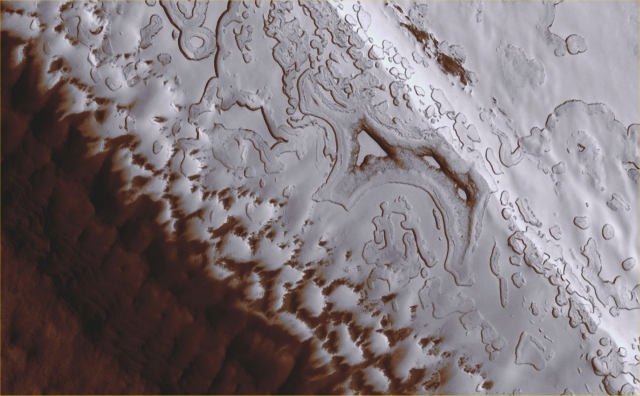
April 11, 2012
Credits: NASA/JPL-Caltech/University of Arizona - Credits for the additional process. and color.: Dr Paolo C. Fienga/Lunar Explorer Italia/IPF
|
The South Polar Residual Cap of Mars, rich in Carbon Dioxide (CO2) Ice, is, from a compositional point of view, very different from the North Polar Residual Cap which, on its side, is dominantly made of (formed by) Water Ice. In addition to that, the South Polar Residual Cap of the Red Planet is also morphologically distinct from the Northern one, since it displays a bewildering variety of Rounded Surface Depressions (---> so called "Swiss Cheese Terrain") formed in thin Layered Deposits, and which have been observed to change by a phenomenon known as Scarp Retreat (---> the recession of a relatively steep Hillslope that terminates a Butte, a Mesa, a Cuesta, or any elevated, Plateau-like Surface. Several Geomorphological Processes may be involved, including Undercutting by an Adjacent Stream, Spring Sapping, Mass Movement, Rainwash and, of course, Weathering. Under semi-arid conditions the Scarp Retreat may give rise to a Hillslope that retreats parallel to itself) over an interval of 1 (one) Martian Year (Malin et al., 2001, Science 294, 2146–2148). The climatically sensitive locale of both North and South Polar Residual Caps of Mars strongly suggests that their behavior may help Scientists in the interpretation of (likely very recent) fluctuations (or repeatability) of the Global Martin Climate. The Mars Global Surveyor Mars Orbiter Camera (MOC) images taken during 3 (three) consecutive Southern Summers, were used to map the variety of Surface Features existing in the South Polar Residual Cap and then to evaluate their changes over 2 (two) full Martian Years. The images showed that there were two distinct Layered Units which were deposited at different times and separated by a period of Degradation. The Older Unit, ∼10 mt thick, showed Layers approximately 2 mt thick, while the Younger one had variable numbers of Layers, each ∼1 mt thick. The Older Unit was being eroded by Scarp Retreat, averaging 3,6 mt per Martian Year: a rate sensibly greater than the one (of approximately 2,2 mt per Mars Year) observed for the Younger Unit. The rates of Scarp Retreat and the sizes of the different types of Depressions indicate that the history of the South Polar Residual Cap of Mars is basically made of short Periods of Deposition (i.e.: growth) interspersed with longer Erosional Periods (i.e.: retreat). In other words: the South Polar Residual Cap of Mars appears to be slowly, but continuously, retreating. The Erosion of the abovementioned Older Unit probably occupied ∼100 to 150 Martian Years and one Layer could have been deposited just after the NASA - Mariner 9 Spacecraft observations made in the AD 1972. The South Polar Residual Cap Layers appear to differ from normal annual Winter Deposits by having a higher Albedo and, perhaps, higher Porosities. One believable explanation for these properties is that they might be produced by differences in the Depositional Meteorology that affect the fraction of High Porosity Snow included in the Winter Deposition. Mars Local Time: 20:06 (Early Evening Hours) This frame has been colorized in Absolute Natural Colors by (such as the colors that a human eye would actually perceive if someone were onboard the NASA - Mars Reconnaissance Orbiter and then looked down, towards the Edge of the South Polar Residual Cap of Mars), by using an original technique created - and, in time, dramatically improved - by the Lunar Explorer Italia Team.
|
News visualized: 653 times

